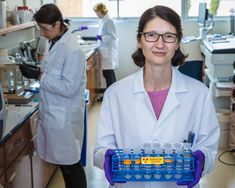Neue Lehrveranstaltung
Gastprofessur: Professor Ruth M. Tinnacher, California State University East Bay
Kann Cadmium leicht von Pflanzen aufgenommen werden? Wird Zink in Spinatblättern akkumuliert?
Breiten sich Urankontaminationen in Böden und Grundwässern aus?
Dies hängt alles von der chemischen Speziation von Schadstoffen in der Umwelt ab.
Dieses Wintersemester wird eine neue Lehrveranstaltung versuchen, diese Fragen zu beantworten.
In the Environmental Chemistry and Modeling course, we will explore the chemical processes that control the behavior of contaminants in the environment with a primary focus on the chemical speciation of inorganic contaminants in water. Chemical speciation is the distribution of chemicals among their various chemical forms, which ultimately determines their bioavailability, toxicity and mobility in the environment. Chemical processes that control the chemical speciation of contaminants in the environment include acid-base chemistry, redox and complexation reactions in solution, as well as dissolution, precipitation and sorption processes involving solids.
After an introduction to the concepts behind chemical speciation, students will apply their theoretical knowledge to the solution of real-world problems based on mathematical calculations (hand-calculations and Excel) and graphical methods. In addition, students will be trained to use a free, modeling software (Visual MINTEQ), which will prove useful for solving various other questions outside the classroom in the future.
At the end of the course, students will apply their new knowledge in a modeling project, and present their results to a small audience of external, international judges in PowerPoint presentations. If student interest exists, we will arrange for a virtual field trip to the Advanced Light Source (ALS) at Lawrence Berkeley National Laboratory to introduce students to the application of synchrotron-based spectroscopy in environmental chemistry research.

